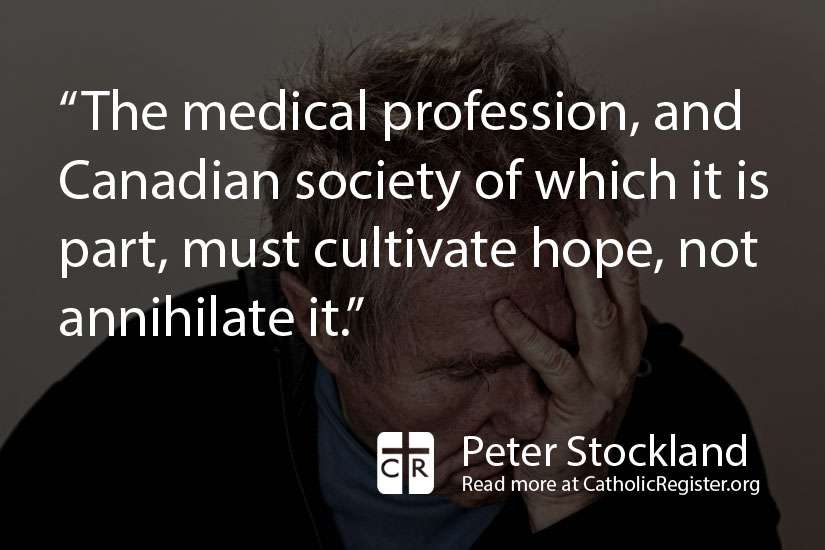September is, as public service advertisements and awareness materials remind us, Suicide Prevention Month. Yet as Dr. Tim Lau, a psychiatrist at the Royal Ottawa Mental Health Centre points out, the suicide promotion path we’re pursuing risks almost doubling our suicide rate in future.
Lau pointed out in a recent interview that in Belgium and the Netherlands, doctor-delivered death without consent — that is, outside the existing law — amounts to about two per cent of all causes of mortality. Canada’s current suicide rate is 1.8 per cent of all causes of mortality. It is “a fantasy,” Lau said, to think abuses elsewhere won’t be repeated here.
In effect, we will continue to pursue good-faith suicide prevention strategies while simultaneously erasing any progress simply through “legal” assisted suicides. Of course, if those strategies are no more effective tomorrow than today, we’ll actually risk doubling the number of suicides.
And if you think there’s a natural curb on the number of people taking their own lives, think again.
“One thing we’ve seen in the last 50 years is that youth suicides (have) gone up by 500 per cent,” Lau told me. “It’s the rationalization of suicide. If you throw your life away, you devalue all human life in the society around you. If human suffering can be eliminated with suicide, then it’s going to become an option for anyone who suffers.”
As the hard push begins for doctor-delivered death to be made available to the mentally ill, that “option” cannot help but drive suicide rates higher. The push is already on. Before the ink was dry on the new legislation last June, groups were lining up to launch legal challenges to its limitations on suicide for children and the mentally ill. A media campaign is inevitable. It may have been test driven in a summer issue of The Walrus magazine featuring a plea from a man suffering debilitating depression that he be allowed to seek medicalized death as if he had terminal cancer.
Such an outcome, Lau says, would be a particular nightmare for the psychiatric profession. He references a colleague who favours euthanasia but is adamantly opposed to extending it to those with mental illness.
“Psychiatrists are struggling with this because our profession has spent most of its history fighting suicide, and suddenly there’s this possibility that it will be considered a form of treatment.
“Those who treat people who are suicidal are asking at what point do you say it’s okay for someone who’s depressed to ask for suicide? Is it after a certain amount of treatment? Is it after electroconvulsive therapy? There is a clear conflict of suicide prevention versus suicide promotion and facilitation.”
There is also, he says, the complex matter of determining capacity to make such a decision. Whether it’s depression or some other mental illness, if your illness causes a distortion of thinking that leads you to believe your world and your future are hopeless, how much of that loss of hope can be understood as a product of the illness, and how much accepted as rational?
Both capacity and desire also change, Lau says.
“The majority of people actually think of suicide at some point in their life. But if you look at the survivors among people who jump off the Golden Gate Bridge, 75 per cent of them changed their mind and wanted to live the instant they jumped.”
The attempted suicide of a human being is a sign of lost hope. The death of a suicide is the death of hope. But the medical profession, and Canadian society of which it is part, must cultivate hope, not annihilate it.
“Imagine the alternative. Imagine saying: ‘You know what? You’re right. Your life is worthless. You’re better off dead.’ ”
That would be a sign not only of a lost way, but of stepping off into the abyss. Can that be where Canada is headed?
(Stockland is publisher of Convivium magazine and a senior fellow with Cardus.)


